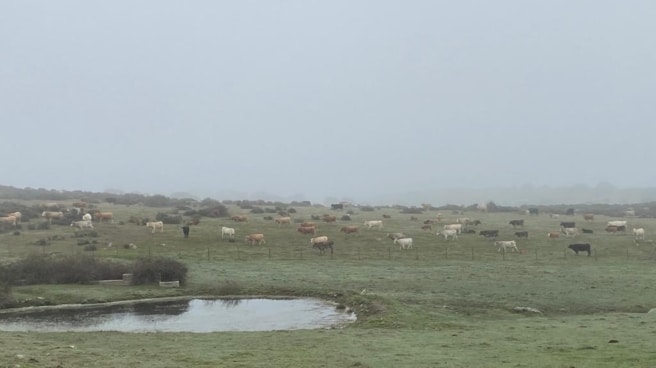

Full pond on an extensive livestock farm

Farmers and ranchers’ eternal gaze to the sky finds its first fruits with the arrival of autumn. Heavy rains are particularly felt in Castile and Leon, Galicia and the northern half of Extremadura, areas where most of the Spanish livestock are concentrated. In addition, water facilitates the sowing of winter grain crops such as wheat, barley and rye, work that continues from October to February.
Passage of storms such as Alain and Bernard They filmed on the peninsula in early autumn in Spain. Warnings of wind, rain and waves were issued as early as October, while grain farmers and large livestock producers enjoyed the cloud relief. “With the exception of extreme cases, these rains were more than positive for the country’s large harvests,” sources in the technical services of ASAJA (Agrarian Association of Young Farmers) indicate in a conversation with the publication. Independent.
The agricultural organization insists that the findings will be completed after Storm Bernard passes, although they clarify that “we are still in a drought situation across much of the country. The normal thing is that from this moment the reservoirs begin to recover.” the assessment can only be positive. The fact that fall weather is starting to arrive is great news. We hope that the rainfall will become widespread and regular, because the problem is that the rainfall is getting worse and worse because the rainfall is concentrated rather than dispersed over time,” ASAJA technical services noted.
Heavy rains contributed to large harvests
From October 11 to October 17, more than 30 l/m accumulated.2 in large areas of the Cantabrian coast, Galicia, most of Castile and Leon, Extremadura, western Andalusia, coastal areas of Catalonia and the eastern islands of the Balearic archipelago, according to AEMET (State Meteorology Agency)
ASAJA believes that the October rains will be favorable for the main crops grown at this time in rural Spain: olives and herbaceous crops. “This rain is fantastic for the olives. There will be places where the storm will cause damage, but to be clear, more oil will be gained than lost. This water is great for olives and the olive tree,” he said. in ASAYA.
The feeling conveyed from the field is one of “relief and excitement.” ASAJA technical sources highlight the importance of these rains for the planting of winter grains such as wheat, barley and rye. According to the Ministry of Agriculture, Fisheries and Food, an average of 6 million hectares of cereals are grown in Spain, making it “the sector with the largest territorial base and distribution throughout the territory.” Of the areas planted with grains in 2020 (excluding rice), almost 94% were winter grains.
“If we plowed in dry weather, it would be a disaster. The cost situation is tough, but at least it’s raining and that’s encouraging people to plant because there are better conditions for the seeds. If there is a good climate, implantation is facilitated and ensures that preparation, fertilization and sowing are carried out under favorable conditions,” states ASAJA.
Respite for extensive livestock farming
In the past year, extensive livestock farming has been exposed to serious threats such as avian influenza, sheep pox, tuberculosis and bovine hemorrhagic disease; However, the rains provide respite for ranchers. “For pastures, this water is salvation,” notes ASAYA.
Agricultural association technicians point out that the ideal would be to have a “real fall” before the winter cold to allow the grass to grow sufficiently and thus reduce feed use: “The nutritional supplement has reduced its value compared to last year. , but still expensive. Not to mention the problem with feed and straw, the price is sky-high.
The drop in temperature that accompanies precipitation becomes a fundamental weapon in the fight against hemorrhagic disease in cattle, caused by the culicoides mosquito, the same insect that transmits bluetongue disease. It is predicted that as temperatures drop, the mosquito will die and spread will cease.
Source: El Independiente